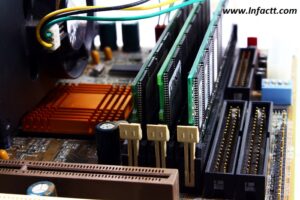Random-Access Memory (RAM)

Random Access Memory (RAM) consists of memory chips that can be read from and written to by the processor and other devices. When the computer is powered on, certain operating system files (such as the files that determine how your windows desktop displays load from a storage device such as a hard disk into Random Access Memory (RAM). These files remain in Random Access Memory (RAM) as long as the computer is running. As further programs and data are entreated, they also load from storage into RAM.

The processor interprets the data while it is in Random Access Memory (RAM). Throughout this time the innards of RAM may change. Random Access Memory (RAM) can hold multiple programs simultaneously, provided the computer has enough RAM to accommodate all the programs. The program with which you are working is usually displayed on the screen.
Most Random Access Memory (RAM) is volatile. It drops its contents when the power is detached from the computer. For this reason, you must save any times you may need in the future. Saving is a process of copying items from Random Access Memory (RAM) to a storage device such as a hard disk.
Two basic types of RAM chips exist Dynamic RAM and static RAM chips. Sometimes called main memory, dynamic RAM chips are the most common types of RAMS.
Dynamic Random Access Memory
Dynamic RAM, or DRAM (Pronounced DEE-ram), chips must be re-energized constantly or they lose their contents. Many variations of dynamic Random-Access Memory chips exist, most of which are faster than the basic DRAM. Synchronous DRAM (SDRAM) chips are much faster than Dynamic Random-Access Memory chips because they are synchronous to the system clock. Double data rate SDRAM (DDR SRAM) chips also called SDRAM II chips, are faster than SDRAM chips because they transfer data twice in each clock cycle, instead of just once. Direct Ram bus DRAM (Direct RDRAM) chips are yet another type of DRAM chip that is much faster than SDRAM chips because they use pipelining techniques. Most computers today use some SD Random Access Memory chips or RDRAM chips.
Static Random-Access memory (RAM)
Static Random-Access memory (RAM) chips also called SRAM (pronounced ESS-ram) chips, are faster and more reliable than any variation of DRAM chips. These chips do not have to be re-energized as often as DRAM chips; thus, the term static is used. Static Random-Access memory (RAM) chips, however, are much more expensive than DRAM chips. Random-Access Memory (RAM) chips often are smaller in size than processor chips. Access Memory (RAM) chips usually reside on a small circuit board, called a memory module, which inserts into the motherboard.
Physical Memory Modules
Two types of physical memory modules are SIMMs and DIMMs.
Single In-Line Memory Module (SIMMs), printed circuit board, or card, that provides Random-Access memory (RAM) for a computer. SIMMS is usually about 10cm (4 in) long by 2cm (0.8 in) tall and provides from 1 to 16 megabytes of Random-Access memory (RAM). The integrated circuits that provide Random-Access memory (RAM) are mounted only on one side of the SIMM. A row of copper points, called pins are coupled to the SIMM along one long side. These jots fit in a hole in the main circuit board or motherboard of a computer.
A dual In-Line Memory Module, or DIMM, in computer science, is a printed circuit board that adds Random-Access memory (RAM) to the computer when attached to the main circuit board (the motherboard) of the computer. DIMMs are replacements for SIMMs (single in-line memory modules). By mounting memory chips on both sides of the circuit board and using twice as many contacts (the shiny metal teeth on both sides of the circuit board that fit into the slot on the motherboard) as a SIMM, a DIMM can hold twice as much memory as a SIMM in the same amount of space.
RAM Requirements
The volume of Random-Access memory (RAM) a computer wants often depends on the kinds of applications you plan to use on the computer. A computer only can operate data that is in memory. Random-Access Memory (RAM) is similar to the workspace on the top of your desk. Just as a desktop needs a certain amount of space to hold papers, pens, a staple, your telephone, and so on, a computer needs a certain amount of memory to store application programs and files. The more Random-Access Memory (RAM) a computer has the more programs and files it can work on at once.
A software package usually indicates the minimum amount of Random-Access Memory (RAM) it requires. If you want the application to perform optimally, you usually need more than the minimum specifications on the software packages.
Generally, home users running windows and using standard application software such as word processing should have at least 32 MB of Random-Access Memory (RAM). Most business users that work with accounting, financial, or spreadsheet programs, voice recognition, and program requiring multimedia capabilities should have a minimum of 64 MB of RAM. Users composing multimedia presentations or using graphic-intensive applications will want at least 256 MB of RAM.
The amount of RAM on the computer determines the number of programs and data a computer can handle at one time, which affects overall performance. The more RAM the faster the computer will respond.




One thought on “Random-Access Memory (RAM)”